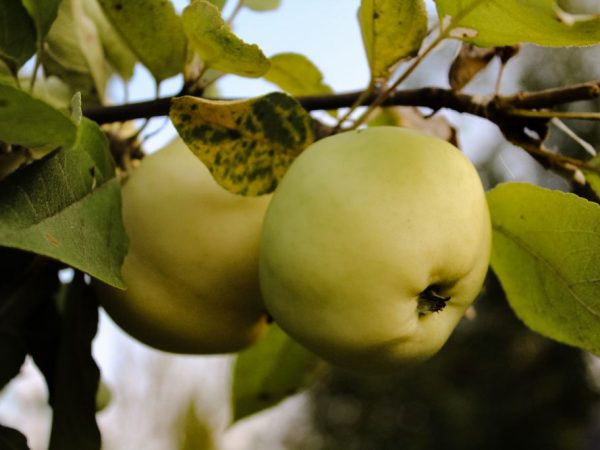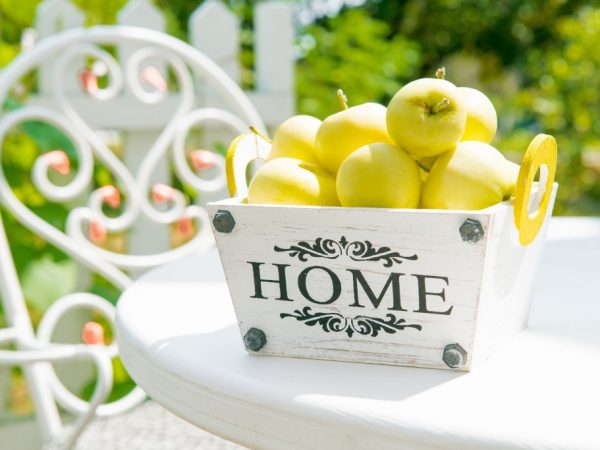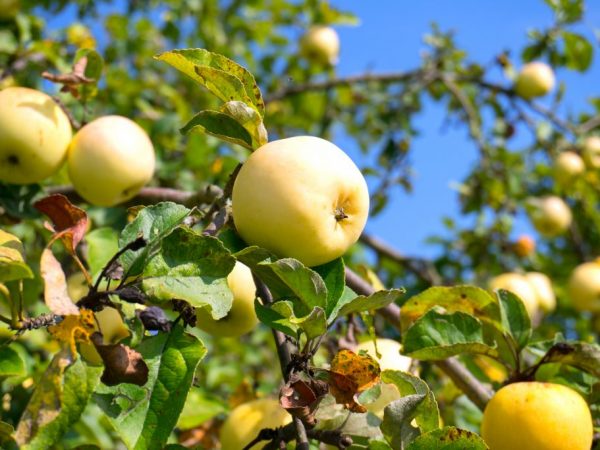Growing Jung's apple tree
Jung's apple tree (Snow White) is picky about the soil, requires special care, protection from the wind and does not give high yields for the first 10 years after planting. The variety is winter hardy, so it can grow and bear fruit in different continental territories. The fruits themselves are delicious and in great demand.
- Characteristics of the variety
- Wood
- Fruit
- Yield
- Pollinator varieties
- Winter hardiness
- Disease and pest resistance
- Fruit application
- Subspecies and variants
- Landing
- Timing
- Technology
- Care
- Watering
- Top dressing
- Pruning
- Protection from pests and diseases
- Features of fruiting
- Harvesting and storage
- In which regions are they grown
- Gardeners reviews

Growing Jung's apple tree
Characteristics of the variety
According to the description, the Jung variety was bred not so long ago, it became a hybrid of 2 apple trees: White filling and Invincible Grell in Altai.
We got it in 2001, then they began to study it. After 3 years, the seedlings were already sold and grown. And at the moment this variety is insanely popular.
Wood
The apple tree looks neat, it reaches a height of 1.5-3 m. Despite its small length, the crown of the tree is lush, the branches are located at an angle of 90 °, respectively, of the trunk. Because of this, it is better to monitor them and prune the crown in time so that the tree grows correctly and evenly.
Shoots are straight and brown, have a small light edge and a lot of lentils. The leaves are medium in size, light green in color, have the shape of an oblong oval, the edges are serrated, and the surface is wavy, with a few villi.
Fruit
Jung's apples are neat, small and have a white color with a yellowish tinge, which is why they resemble White filling.
The weight of one is from 50 to 80 g, and the diameter is 6-8 cm. The peel is thin, it is removed quite easily and there is a waxy coating on it.
According to the description, they grow in small groups - 3-4 pieces each, on a branch as a whole there are 15-20 pieces. The stem of the fetus is long, attached to different rings. Inside, the pulp is juicy, soft, sweet and fine-grained.
Apples have a sweet taste with a hint of sourness. As part of the fruit:
- sugar - 11%;
- acids - 0.8%;
- vitamin C - 18 mg;
- active compounds - 200 mg.
Yield
Apple tree "Junga" does not have a high level of productivity, but the variety has its own characteristics. A young tree does not bear fruit, except as an exception. The first harvests begin 4 years after planting, then no more than 10-15 kg of apples can be harvested from one tree.
After 8 years of life, the yield doubles, and then 25-30 kg of apples can be harvested from one apple tree, and even more from a dwarf crop. To list fruits for sale, it is better to plant 10 or more trees.
The fruits ripen in August and, if the number of apples on the tree is large, they must be plucked all at once to avoid falling and decay. After a while, apples will grow on the tree again.
Starting from 4 years old, the tree gives from 7 kg of fruits. The yield will change annually.
If you harvested 10 kg of apples this year, next year you will harvest 1-2 kg less, and again in a year more.
Pollinator varieties
Snow White is considered a self-fertile tree.But it will not be superfluous to have 2-3 more trees of other varieties of apples on the garden plot.
Winter hardiness

Fruit yield is not very large
Jung's apple tree loves the autumn-summer period, but its winter hardiness is defined as average. It tolerates low temperatures normally, but sometimes there is freezing in case of frost.
When spring comes and the snow begins to melt, and scabs are visible in patches on the tree trunk on young leaves, you don't have to worry. The minimum amount of scab does not harm in any way.
If the air temperature drops to -40 ° C, the branches freeze, but with the onset of heat, the tree quickly recovers and bears fruit again.
Disease and pest resistance
Jung's apples have good immunity, the only thing that can affect the variety is scab, and that in small quantities.
Scab usually appears after rain, and it is noticeable on the fruit of the tree. Apples turn brown, they should be picked and thrown away, and rotten apples should be picked up from the ground and also taken out so that neighboring fruits do not get infected.
Fruit application
Snow White fruits are multifunctional for use: they are rich in vitamins and minerals.
Usually these small and tasty apples are taken to children, they are eaten raw, added to salads and desserts, baked, dried for compotes and preserved for the winter.
It has been verified that vitamins are not in the peel and pulp itself; most of them are concentrated in the seeds. They contain the daily dose of iodine for humans.
Subspecies and variants
Separate apple varieties have not yet been identified, there is only a dwarf Jung. Other subspecies will appear a little later.
Landing
In order for an apple tree to give good yields and grow for more than one year, you need to know how to plant it, grow it correctly, and what conditions are needed for this.
Timing
Snow White loves the warm seasons, so it is best to plant her in the spring or fall. In the spring, they choose the period when the buds bloom on the seedling, but in the fall - when the leaves on the trees fall.
Technology
Yoongi's seedlings need to be bought from friends or from proven nurseries. When buying, pay attention to them so that there are no stains, breakages and other imperfections on the bark.
If you plant an apple tree in the fall, it is enough to dig it at an angle of 45 ° and leave it until spring, and if the seedling is spring, you need to dig a hole in advance, leave it for 2 weeks, and then plant the plant.
It is important to choose a good and bright place for the tree so that it is comfortable to grow. There should be no groundwater nearby, it is impossible for water to stagnate. If at least some probability is allowed, drainage is done. If possible, the young tree should be protected from the winds.
The seedlings are small, so a hole 40 cm deep and 60X60 cm to the sides is enough. The hole is left for 2 weeks, before direct planting, a tubercle is made at the bottom, on which the seedling is placed with the root and the root system is straightened. You can add humus to the bottom.
It is necessary to cover the seedling with soil quite a bit to cover the roots and make sure that the tree holds and does not fly away. Better to tie it up. Then the ground at the trunk is trampled down.
Care

Weather conditions affect the growth of the apple tree
An important role is played by caring for the apple tree, because the result of the harvest will directly depend on how the tree is looked after.
Watering
Initially, you need to immediately water the seedling well after planting. Then two are considered mandatory watering per season - in the spring they pour up to 100 liters of water on a tree over 4 years old. In the fall, water is given when the tree begins to shed its leaves, and this watering should also be abundant. The rest depends on the weather conditions.
Top dressing
The tree is fed with organic and mineral fertilizers, as well as wood ash, manure and chicken droppings. If fertilizer is applied in the fall, then the soil is dug up, and in the spring, fertilizing is done by mulching. All fertilizers are poured around the trunk.
Pruning
This important point is needed for the tree to produce a good harvest. Only dense sections of branches are cut off.If the crown of the tree is not dense and of the correct shape, sunlight will evenly pass through the tree.
Also, all branches will succumb to natural ventilation, because of which the tree will clean itself and the risk of being affected by various diseases will significantly decrease.
Protection from pests and diseases
The tree itself protects itself from pests and diseases. Gardeners should treat their plants with insecticides and protect young seedlings from the wind.
Features of fruiting
Usually, the crop begins to ripen 4-5 years after planting, sometimes it happens that the buds open even after 3 years.
The tree blooms in early May, when there is enough warmth and sunny color outside. Fruits ripen in the month of August.
Harvesting and storage
They begin to pick apples already in August, and if the summer was cold, often the fruits of Snow White are picked in September.
The shelf life is no more than a month, and then all conditions are met. Because of this, the crop is mainly used for processing: drying, for jam or baking.
In which regions are they grown
According to the description, the variety was bred by breeders of the Altai Territory, they made it resistant to many weather conditions. This played into the hands of many gardeners, so Jung is grown in all sorts of regions of the European continent.
Despite the low preservation rates, the variety has become one of the most popular in Russia.
Gardeners reviews
Young's apples have an exceptional taste, besides, they are healthy and suitable for various preparations and baking.
For many, it is the taste and smell of childhood. Those who grow an apple tree of this variety notice that it does not freeze and brings good yields.

